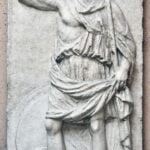Polybius square is (known also as Polybius checkerboard) a type of monoalphabetic cipher (the hidden letter corresponds to the open letter), which owes its name to the famous ancient historian and writer – Polybius. As Polybius himself tells us in his “Histories”, the author of the cipher are the Greeks – Cleoksenos and Democletus – but it was he who undertook to improve the mechanism.
Polybius’s square consisted of five tablets, with five Greek letters on each (the exception was the last one, where there were only four letters; in the Latin version, each tablet has five letters). No original tablet with the cipher has survived to our times. Next to it, there is a square of Polybius in the Latin version.
Generally, the principle of encryption consisted in providing specific digits that indicate the position of a given letter in the table – the first digit is the row number, and the second – is the column. Thus, the word: CAESAR in the encrypted version takes the form: 13 11 15 43 11 42.
According to Polybius, improving the encryption of messages was important for sending urgent and non-obvious information. Previous methods allowed sending only predetermined and expected message formats.
In order for the message to be passed on, both parties had to have signs with the alphabet on them. Transmission of signals was carried out using light signals (torches) and, according to Polybius, the signalers on both sides had to first confirm that the transmission of the message was possible at the moment. For this purpose, the person sending the information raised two torches and waited for a similar answer from the opposite side. Then, when both parties were sure that the transmission of the cipher was possible, the person sending the message raised the appropriate number of torches on the left side, pointing to the row-table. Then the sender raised the appropriate number that comes to the right, indicating the column. In this way, it was possible to send a message at a distance, e.g. between military posts.








